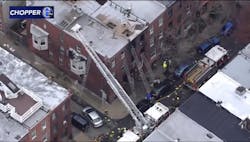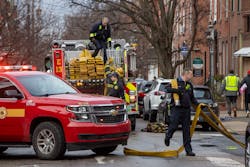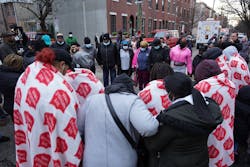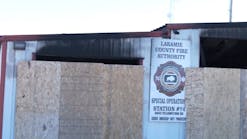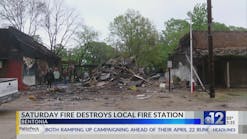12 Dead in Philly Rowhome Fire
By Anna Orso, Rodrigo Torrejón and Ryan W. Briggs
Source The Philadelphia Inquirer
PHILADELPHIA — A catastrophic fire tore through a rowhouse in Philadelphia’s Fairmount neighborhood before sunrise Wednesday and killed 12 people, including eight children, in one of the nation’s deadliest residential fires in decades.
Authorities did not identify the victims, but relatives and friends said they included two mothers and their children, some who attended a nearby elementary school and one possibly as young as 2. Together, they occupied the top unit of a three-story brick home in which at least four smoke detectors weren’t working.
Investigators couldn’t say what sparked the 6:30 a.m. blaze or why it became so deadly so swiftly. Federal agents were expected to join Philadelphia fire marshals in what is likely to be a complex and lengthy probe.
The loss gripped the city and rippled across the country, drawing condolences from Gov. Tom Wolf to first lady Jill Biden. In Fairmount, a stately neighborhood just northwest of Center City, residents who were shaken awake by the sound of sirens and a woman screaming soon embraced on the sidewalk as first responders choked back tears.
“This is without a doubt one of the most tragic days in our city’s history,” an emotional Mayor Jim Kenney said during a morning news conference on the block. “Losing so many kids is just devastating.”
“When I go visit Philly, it’s going to be a void,” she said through tears.
Another relative, Keta Purifoy, said the family was asking for privacy and prayers. “I don’t know what to say,” she said. “I’m numb.”
Late in the day, a few people gathered in the neighborhood for a small vigil.
The 2,300-square-foot building housed two apartments and is owned and operated by the federally funded Philadelphia Housing Authority. The four-bedroom upper unit where the victims lived appeared to house 18 people, three times as many as were living there when the families moved in about a decade ago, officials said.
Philadelphia Police Cpl. Jasmine Reilly said an initial 911 call was answered just after 6:30 a.m. Fire crews arrived on the scene within five minutes. They found flames shooting out the windows of the second floor and the “heavy fire” had already run up an open stairwell into the third, said Craig Murphy, first deputy commissioner of the Philadelphia Fire Department.
Of the 26 people housed in the building — eight in the lower unit — eight people had escaped and two others, an adult and a child, were taken to the hospital with serious injuries.
“Nothing was slowing that fire down,” Murphy said, adding that “aggressive attack” from firefighters got the blaze under control after about 50 minutes.
Early in the day, he had said the death toll was 13 but cautioned the number could change. By evening, officials revised that number to eight children and four adults. As night fell, police vehicles carrying the bodies of the victims departed the scene in unison.
With a dozen dead, the blaze ranks among the deadliest house fires in the last 40 years, according to the National Fire Protection Association, a trade group that identified just five other fires that have taken more lives since 1980. It also becomes one of the deadliest disasters in city history — worse than a 2008 house fire that claimed the lives of seven in Southwest Philadelphia, and more deadly than the 2013 Salvation Army building collapse that killed six people.
Andrew R. Duffy, a lawyer with Saltz Mongeluzzi & Bendesky who has represented disaster victims, said it’s highly uncommon to see so many casualties from a residential blaze. “They usually get out of the house if there is a working smoke alarm,” he said.
Murphy said at least four battery-operated detectors in the building did not work Wednesday.
“I’ve been around for 35 years now, and this is probably one of the worst fires I’ve ever been to,” he said. “We plan on making sure that this tremendous loss of life did not happen in vain.”
Why the smoke detectors weren’t working was among many unanswered questions Wednesday. PHA officials said that six detectors were installed in the two units in 2019 and 2020 and that they were operational during inspections of both apartments last spring.
During one of those inspections, batteries for two of the six smoke detectors were replaced, said Dinesh Indala, executive vice president of housing operations for PHA.
The deputy fire commissioner also said 26 people living in the building’s two units is “a tremendous amount of people.”
Kenney said there may have been valid circumstances that led to so many people under one roof. “Maybe there were people or relatives that needed to be sheltered,” he said.
Some questioned whether the victims were able to escape the structure. Kerry Pusey, 37, a graduate student who lives nearby, said most of the houses on the block are triplexes — three apartments per building. He lives on the second floor of his and wondered how he would escape in a fire.
“These buildings are very old,” he said. “I have no idea how I’d get out. I’d have to go out the window.”
Murphy said there were two exits on the first floor of the building, and no fire escapes were visible. But city code doesn’t require fire escapes for buildings of that size; Karen Guss, a spokesperson with the city’s Department of Licenses and Inspections, said one exit is sufficient under city code for a residential, two-family house with three floors.
As investigators collected evidence and studied burn patterns, residents draped in blankets huddled in the cold on the leafy, narrow blocks just north of the city’s iconic Benjamin Franklin Parkway.
Alice Wright, who lives three blocks away from that stretch of 23rd Street, leads the United Block Captains Association and came to the scene to offer help to relatives of those who died.
“Oh my God. I’m speechless,” said Wright, 80. “I cried so much.”
City Council President Darrell L. Clarke, who represents the area in Council, stood alongside Kenney on Wednesday morning and struggled to find the words.
“This punches you in the gut,” he said. “Children. People in the community. It’s just tragic. I don’t know what to say. It’s so sad.”
___
(Philadelphia Inquirer staff writers Ximena Conde, Mensah M. Dean, Marina Affo, Aubrey Whelan, Robert Moran and Sean Collins Walsh contributed to this article.)
___
©2022 The Philadelphia Inquirer, LLC. Visit at inquirer.com. Distributed by Tribune Content Agency, LLC.
Watch the full press conference below.
